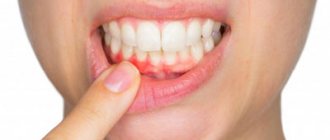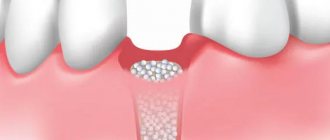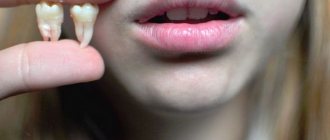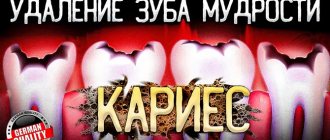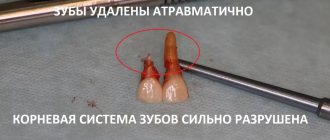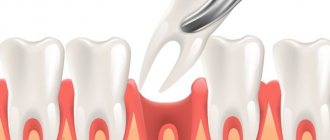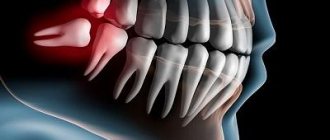Also watch: Important questions about anesthesia and sedationTeeth extraction under sedationCost of sedationWhat is drug-induced sleep in dentistry
For many people, dental implantation is the most reliable and optimal option for restoring the dentition. There are several types of dental implantation, the fastest of which is considered to be one-stage implantation. The peculiarity of this manipulation is that tooth extraction and implant installation occur immediately one after the other during one visit to the dentist. It is when carrying out this type of intervention that painless tooth extraction before implantation, delicate and non-traumatic, is of great importance. Failure to comply with the tooth extraction technique before immediate implantation can become a serious obstacle to performing this procedure.
Also, minimal trauma during tooth extraction is important before other options for dental implantation, as well as before osteoplastic surgery. Modern dental clinics offer their patients quick and painless tooth extraction using modern equipment and painkillers. Non-traumatic tooth extraction and the absence of pain in the patient are prerequisites for successful subsequent implantation and prosthetics.
In what cases is simultaneous implantation indicated?
The main indication for simultaneous dental implantation is the loss of one or more teeth, provided that an important condition is met, namely, maintaining the required volume and strength of the jaw bone.
It is recommended to perform one-stage implantation with preliminary tooth extraction when:
- Traumatization, when part of the tooth is damaged and it is not subject to conservative treatment. As a rule, if you consult a dentist in a timely manner after an injury, the bone tissue does not have time to undergo pathological changes and simultaneous implantation is possible with non-traumatic and painless removal of the injured tooth;
- Advanced stages of caries, in which the inflammatory and destructive process does not affect bone tissue. If conservative methods of caries treatment cannot help the patient (most of the tooth crown is destroyed), then it is best to carefully remove the tooth and perform a one-stage implantation;
- The need to restore the dentition as quickly as possible. Single-stage implantation is considered the operation of choice for patients whose professional or social activities require constant contact with people, and therefore require an appropriate appearance. The efficiency of the procedure is the main advantage of one-stage implantation among other methods of dental restoration;
Tooth extraction followed by implant installation is possible only if several important conditions are met. In addition to the absence of atrophic processes in bone tissue, complete sanitation of the oral cavity and the absence of symptoms of inflammatory gum diseases and other dental pathologies are necessary. Therefore, in addition to delicate and low-traumatic tooth extraction before implantation, it is also important to comprehensively prepare the patient for the intervention in order to obtain the desired result from implantation and minimize possible risks.
The main reasons for tooth extraction:
- Atrophy of the bone tissues of the oral cavity by 70% or more (of the length of the tooth root);
- Destruction of hard dental tissues by 70% or more;
- Excessive tooth mobility;
- Growth of the root cyst up to 7 mm or more (if the cyst could not be eliminated therapeutically);
- Indications for an orthodontist when correcting a crooked bite;
- Removal of a wisdom tooth that may grow crookedly and cause harm to neighboring teeth;
- Growth of supernumerary (extra) teeth;
- The presence of a baby tooth in an adult, if there are no rudiments of a permanent one (for installation of implants);
- Roots that cannot be cured and cannot be prosthetized;
- Removal of decayed teeth during pregnancy.
When is an intervention not recommended?
Despite the fact that one-stage implantation is considered the most convenient way to restore the dentition, its disadvantages include the presence of a large number of contraindications:
- Atrophic processes in bone tissue in the intervention area;
- The patient has osteoporosis;
- Diseases of the blood coagulation system;
- Endocrine pathologies (decompensated diabetes mellitus);
- Immunodeficiency conditions;
- Inflammatory gum diseases (relative contraindication, that is, the procedure is possible after the patient has completed the full course of treatment);
If there is at least one of the above contraindications, installing an implant immediately after tooth extraction is impossible and another treatment option is selected. Also, the process of tooth extraction itself in cases where the patient has these pathologies requires a special approach and is performed in the most gentle manner possible.
Contraindications: when tooth extraction is not permitted
It is not always possible to perform tooth extraction without pain. The procedure should be avoided if the patient:
- there are acute diseases;
- you are pregnant in the 1st or 3rd trimester;
- there are diseases with local skin lesions (herpes, fungus, syphilis);
- diagnosed with mental illness;
- have blood diseases,
- radiation therapy is performed;
- There are cancers that are treated with chemicals.
In such cases, it is better to postpone the extraction.
How is preparation carried out for tooth extraction and subsequent implantation?
Since the quality of implantation depends on how carefully the dentist removes the tooth, each patient is required to undergo thorough preparation for this procedure, which includes a preliminary examination and some preparatory manipulations:
- The degree of tooth destruction, the presence or absence of structural anomalies in the implantation area are assessed;
- Additional instrumental research methods are carried out: X-ray, CT. With their help, the doctor assesses the condition of the bone tissue, as well as the roots of the tooth, including their location in relation to the paranasal sinuses;
- Instruments for tooth extraction and the optimal method of pain relief for the patient are selected;
- A set of treatment measures is prescribed in the presence of concomitant dental pathologies;
- If necessary, professional teeth cleaning is performed, which can effectively reduce the risk of infectious complications during the rehabilitation period;
- The day before tooth extraction, in many cases antibiotic therapy with a broad-spectrum drug is prescribed;
Before tooth extraction, it is also very important to ensure the correct psychological attitude of the patient. To do this, the doctor must explain to the patient in detail how the procedure will be performed, why certain manipulations are performed, and what results should be expected after tooth extraction and implant installation. In addition, the patient must be explained what kind of anesthesia will be used during the operation and how it works.
A special place in preparation for tooth extraction is occupied by sedation of the patient. To conduct mild sedation, the doctor must take into account the psycho-emotional characteristics of the patient, the degree of his anxiety before the upcoming manipulation. In modern dentistry, safe and effective drugs are used to provide sedation, which quickly eliminate such undesirable manifestations as severe fear, psychomotor agitation and others. Without proper psychological preparation of the patient and well-chosen sedation, painless tooth extraction before implantation is very difficult to carry out delicately and non-traumatically.
How to remove a tooth without pain?
In modern dental practice, tooth extraction is not carried out without high-quality, reliable and safe anesthesia for the patient’s health. In the vast majority of cases, when removing teeth, local anesthesia is used, that is, the patient remains conscious both during pain relief and during further manipulations. To remove a tooth, dentists most often resort to the injection method of local anesthesia, when an anesthetic is injected into the desired area of tissue by injection. Using the injection method, infiltration and conduction local anesthesia can be performed, while conduction anesthesia is more suitable in cases where several teeth are to be removed at once.
To remove a tooth without unnecessary trauma to the surrounding tissues and without severe stress for the patient, it is necessary to select an effective painkiller. The most common are drugs based on novocaine, lidocaine, ultracaine and some other anesthetics. The main requirements for drugs for local anesthesia are a rapid onset of effect, reliability and a high safety profile.
Before anesthesia, a special sensitivity test to the anesthetic must be performed. This is necessary primarily in order to exclude the development of such severe allergic complications as Quincke's edema and anaphylactic shock. After the dentist is convinced that the drug is safe to use, they proceed directly to pain relief. Several injections are made into the gums, and the patient may notice minor soreness and discomfort, which pass fairly quickly. After the anesthesia begins to take effect, careful tooth extraction begins.
What is needed to prevent injury during tooth extraction?
The correct selection of instruments for tooth extraction before implantation is necessary in order to minimize the risk of trauma to the bone and soft tissues surrounding the tooth. Since even the slightest injury to the alveolar process of the bone makes it impossible to carry out implantation immediately after tooth extraction, dentists use exclusively modern equipment to make the process of tooth extraction as precise and non-traumatic as possible. These include:
- High quality tongs. Selecting the desired shape and bend of the forceps and using them carefully allows you to remove the tooth and tooth roots without injury;
- Periotomes. Used for atraumatic tooth extraction with delicate separation of marginal gums;
- Luxators. They are an improved version of classic elevators, significantly simplify the process of tooth extraction and make it less traumatic;
- Ultrasonic surgical devices, for example, piezotome. Allows you to minimize trauma during tooth extraction and facilitates the rehabilitation period for patients after implant installation;
The quality of the instruments determines how convenient it is for a specialist to perform the operation, which in turn is of great importance for preventing injury to bone tissue and obtaining a good result from dental implantation.
In addition to choosing the necessary tools, the experience and qualifications of the specialist are of great importance.
For an average surgeon, the remains of teeth before surgery are a hindrance and are not treated on ceremony. The result is broken bone structures of the jaw, wandering remnants of roots, unremoved cysts growing into the maxillary sinus, perforations, fistulas, osteomyelitis and much more. Not to mention the shocking post-operative pain that overtakes the patient after such punitive surgery. Entrust removal to an oral and maxillofacial surgeon. Only the maxillofacial surgeon has enough theoretical and practical skills to perform tooth extraction without complications.
Why does the tooth socket hurt and how to speed up the healing process.
After the removal procedure, the patient may experience discomfort in the oral cavity - this is quite natural, as our body reacts to loss. But problems can also be alarming in nature, when you should immediately consult a dentist.
Pain in the gums and swelling last on average up to 5-7 days. Soft and hard tissues have been injured and this is how they respond. The more difficult the removal, the worse the damage will be. If you do not have the strength to endure the pain that arises, use painkillers.
During the healing process, the hole should be filled with a blood clot; if it is not there, or the wound gets infected, a disease develops - alveolitis. This inflammation is accompanied by increasing pain and bad breath. This could be to blame
doctor and patient alike. During the operation, the dentist could partially remove the root, leaving a piece of it in the hole or not completely clean the wound from the cyst. And the patient, in turn, without observing the rules of hygiene, can “rinse out” the blood clot, emptying the hole. In any case, only a doctor can cure alveolitis; he will rinse the hole and fill it with medicine. At the A-medic clinic, the cost of treating alveolitis will be 1,200 rubles.
Some time after removal, the patient may experience bleeding. What should you do in this case? To begin with, you can try to stop the bleeding yourself by making a tampon from a sterile bandage and applying it tightly to the wound. If this does not help, use a hemostatic sponge. You should not expect the blood to stop flowing on its own; try to stop it; if there is no visible result, consult a doctor. One of the reasons for severe bleeding may be damage to blood vessels during the procedure.
For a speedy recovery, you should follow several rules; they will help you recover faster and significantly reduce pain:
- Eating food is allowed only 2-3 hours after the anesthesia wears off.
- Brush your teeth with a soft brush, avoiding direct contact with the socket. Rinse your mouth slowly, being careful not to wash out the blood clot.
- For about a week, you must refrain from eating hot food and visiting saunas and baths.
- In the first two days, do not drink alcohol or smoke.
- For a while, eliminate solid foods from your diet and eat more liquid and soft foods. Chew on the healthy side.
- Under no circumstances should you pick at the wound with foreign objects or touch it with your hands.
! Cleaning the oral cavity by rinsing, drinking a lot of water, spitting is not recommended in the first 3 days. You may damage or wash away the protective blood clot in the socket.
For rapid wound healing, treatment and prevention of alveolitis, the A-medic clinic uses a special dressing (alvogil) - this is a modern antiseptic analgesic compress that has an anti-inflammatory and analgesic effect.
Main stages of the intervention
Tooth extraction is a routine procedure for an experienced dentist. After carrying out a set of preparatory measures and pain relief, the doctor begins to directly remove the tooth. In most cases, the tooth extraction procedure consists of detaching the gums using a special tool, applying forceps to the tooth, and then gently loosening it. After the tooth becomes sufficiently mobile, it is removed from the socket, which is then carefully examined to prevent the presence of bone fragments in it. The final stage is the treatment of the tooth socket, the main purpose of which is to prevent infectious complications.
Sometimes complex tooth extraction may be necessary before implantation. This procedure is resorted to in cases where there are anomalies in the structure of the dentition or severe curvature of the tooth roots. For complex removals, the dentist uses additional instruments and the intervention requires a little more time. If the tooth extraction was atraumatic, the doctor begins the implantation procedure.
Proper oral care after tooth extraction
After tooth extraction, you should adhere to certain rules and recommendations of the dentist - they will help to avoid both discomfort and complications.
- You should not eat for several hours after the procedure. This can damage the surface of the gums that have not yet healed and cause infection.
- Carefully monitor the area where the tooth was - and if it bleeds heavily, consult a doctor.
- If necessary, you can take a pain reliever.
- Do not drink, smoke or eat hot food. All of these actions can help dissolve the blood clot that usually forms in the socket after a tooth is pulled out, which can lead to pain or increase the healing time of the gums.
- If the tooth extraction was complicated (surgically), after 24 hours you should start rinsing the damaged gum with a solution recommended by the dentist.
- Also, if you have a tooth removed surgically, you should not use a hard toothbrush or light mouthwash.
Of course, in most cases, after tooth extraction there is no pain or special discomfort. But to be sure of quick healing, you should follow these recommendations - and, of course, contact doctors from the President clinic. Also, after removal, you can contact our clinic for advice on prosthetics and implantation so that your smile remains the same
Why is it important to adhere to the low-impact principle?
Minimizing trauma to healthy tissues surrounding the tooth is a priority when removing a tooth of any degree of complexity. However, if this procedure is carried out immediately before implantation, then delicate and low-traumatic tooth extraction is necessary not only to protect the patient from unpleasant sensations, but also so that the dentist can reliably fix the implant in the bone tissue.
It is also very important to prepare the patient for the procedure, which, in addition to a comprehensive examination, may include mild sedation to eliminate psycho-emotional discomfort.
Sincerely, Levin D.V., chief physician
Indications: when removal is necessary
Teeth have to be removed due to infections in the mouth that destroy the teeth. It is important to identify and treat such diseases in a timely manner. When therapy does not solve the problem, the tooth has to be removed.
Indications for the procedure:
- inflammation in the mouth
- root fracture,
- destruction of roots,
- gum injury,
- the need to make an arch on the jaw.
Tooth extraction is indicated for patients with periodontitis, cysts, and advanced caries. To prevent the problem, you should carefully maintain dental hygiene. The following also lead to extraction: its fractures, loosening.



